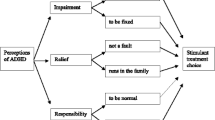Abstract
This study argues that the under-diagnosis of attention deficit hyperactive disorder in Black children is a result of racism that is structurally and institutionally embedded within school policing policies and the tendency to not recognize Black illness. The purpose of this research is to examine how micro-processes lead to structural inequality within education for Black children. It seeks to better understand how institutional racism and flawed behavioral ascriptions lead to the under-diagnosis of attention deficit hyperactive disorder (ADHD) in Black children and how that may also contribute to their over-representation in the “school-to-prison pipeline.” The goal of this study was to review ethnographic, empirical data and examine the ways (1) how racism within some schools may contribute to the under-diagnosis of ADHD in Black children, (2) how their under-diagnosis and lack of treatment leads to their over-punishment, and (3) how they are over-represented in today’s school-to-prison pipeline phenomenon, possibly as a result of such disparities.
Similar content being viewed by others
References
Ahmann, E. (2013). ADHD among African-Americans. Psych Central. Retrieved on April 24, 2014 (http://psychcentral.com/lib/adhd-among-african-americans/00017250).
Alexander, M. (2010). The New Jim Crow. New York: The New Press.
Castellanos, F. X., & Tannock, R. (2002). Neuroscience of attention-deficit/hyperactivity disorder: the search for endophenotypes. Nature Reviews Neuroscience, 3, 617–628.
Centers for Disease Control and Prevention. (1997). Remarks by the president in apology for study done in Tuskegee. U.S. Public Health Service Syphilis Study at Tuskegee. (http://www.cdc.gov/tuskegee/clintonp.htm).
Centers for Disease Control and Prevention. (2014). Retrieved on October 1, 2014. (http://www.cdc.gov/nchs/fastats/adhd.htm).
Crenshaw, K., Ocen, P., Nanda, J. (2015). Black girls matter: pushed out, overpoliced and underprotected. Center for Intersectionality and Social Policy Studies at Columbia University.
Davidson, J. C., & Ford, D. Y. (2001). Perceptions of attention deficit hyperactivity disorder in one African-American community. The Journal of Negro Education, 70(4), 264–273.
Delpit, L. D. (2011). The silenced dialogue: power and pedagogy in educating other people’s children. Harvard Educational Review, p. 280–299.
Demby, G. (2014). Black preschoolers far more likely to be suspended. NPR. Retrieved on April 27, 2014 (http://www.npr.org/blogs/codeswitch/2014/03/21/292456211/black-preschoolers-far-more-likely-to-be-suspended).
Elias, M. (2013). The school-to-prison pipeline. Teaching tolerance: a project of the Southern Poverty Law Center. Number 43.
Fabelo, T., Thompson, M. D., Plotkin, M., Carmichael, D., Marchbanks, M. P., Booth, E. A. (2011). Breaking schools’ rules: a statewide study of how school discipline relates to students’ success and juvenile justice involvement. Retrieved on October 1, 2014 (https://www.ncjrs.gov/App/Publications/abstract.aspx?ID=266653).
Healy, M. (2013). Under-diagnosis of ADHD begins early for some groups. Retrieved on April 27, 2014 (http://www.usatoday.com/story/news/nation/2013/06/24/adhd-minorities-diagnosis/2439647/).
Horn, I. B., Joseph, J. G., Cheng, T. L. (2004). Nonabusive physical punishment and child behavior among African-American children: a systematic review. The Journal of the National Medical Association, 96(9).
Kang-Brown, J., Trone, J., Fratello, J., Daftary-Kapur, T. (2013). A generation later: what we’ve learned about zero tolerance in schools. Vera Institute of Justice, Center on Youth Justice (http://www.vera.org/sites/default/files/resources/downloads/zero-tolerance-in-schools-policy-brief.pdf).
Kauffman, E. (2012). The worst ‘school-to-prison’ pipeline: was it Mississippi? Time Magazine.
Kochman, T. (1983). Black and white styles in conflict. University of Chicago Press.
Loe, I. M., & Feldman, H. M. (2014). Academic and educational outcomes of children with ADHD. Pittsburgh: University of Pittsburgh School of Medicine, Children’s Hospital of Pittsburgh.
McCabe, S. E., Morales, M., Cranford, J., Delva, J., McPherson, M. D., & Boyd, C. J. (2007). Race/ethnicity and gender differences in drug use and abuse among college students. Journal of Ethnicity in Substance Abuse, 6(2), 75–95.
McNeil, C. B., Capage, L. C., & Bennett, G. M. (2002). Cultural issues in the treatment of young African American children diagnosed with disruptive behavior disorders. Journal of Pediatric Psychology, 27, 339–350.
National Institute of Mental Health. (2014). Retrieved October 1, 2014. (http://www.nimh.nih.gov/health/topics/attention-deficit-hyperactivity-disorder-adhd/index.shtml).
Nigg, J. T. (2010). Attention-deficit/hyperactivity disorder: endophenotypes, structure, and etiological pathways. Current directions in psychological science. Retrieved on October 1, 2014. 19:24–29.
Racine, M. B., Majnemer, A., Shevell, M., & Snider, L. (2008). Handwriting performance in children with attention deficit hyperactivity disorder (ADHD). Journal of Child Neurology, 23(4), 399–406.
Rudd, T. (2014). Racial disproportionality in school discipline: implicit bias is heavily indicated. Kirwan Institute for the Study of Race and Ethnicity at The Ohio State University.
Schneider, H., Eisenberg, D. (2006). Who receives a diagnosis of attention-deficit/hyperactivity disorder in the United States elementary school population? Pediatrics, 117(4).
Smith, E. J., & Harper, S. R. (2015). Disproportionate impact of K-12 school suspension and expulsion on black students in Southern States. Philadelphia: University of Pennsylvania, Center for the Study of Race and Equity in Education.
Sonuga-Barke, E. J. S., Sergeant, J. A., Nigg, J., & Willcutt, E. (2008). Executive dysfunction and delay aversion in ADHD: nosologic and diagnostic implications. Child and Adolescent Psychiatric Clinics of North America., 17, 367–384.
U.S. Department of Education, National Center for Education Statistics. (2013). Digest of Education Statistics, 2012 (NCES 2014–015), Ch. 3.
U.S. Department of Health and Human Services. (2006). The rationale for diversity in the health professions: a review of the evidence. Retrieved on October 1, 2014. (http://bhpr.hrsa.gov/healthworkforce/reports/diversityreviewevidence.pdf).
United States District Court Southern District of Mississippi. (2012). United States v. City of Meridian.
Washington, H. (2006). Medical apartheid. New York: Random House.
Acknowledgments
The author would like to acknowledge Zandria Robinson, Anna Mueller, and Wesley James for their advisement during this study.
Author information
Authors and Affiliations
Corresponding author
Ethics declarations
Conflict of Interest
The author declares that there is no conflict of interest.
Rights and permissions
About this article
Cite this article
Moody, M. From Under-Diagnoses to Over-Representation: Black Children, ADHD, and the School-To-Prison Pipeline. J Afr Am St 20, 152–163 (2016). https://doi.org/10.1007/s12111-016-9325-5
Published:
Issue Date:
DOI: https://doi.org/10.1007/s12111-016-9325-5



